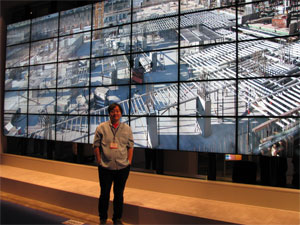Licensing Agreement Makes HIPerWall Software Available
By Anna Lynn Spitzer
Jan. 6, 2009 -- Since 2005, the Highly Interactive Parallelized Display Wall (HIPerWall) in Calit2’s Visualization Lab has transformed enormous research datasets into super-high-resolution images. Now, a licensing agreement makes the custom display-wall software available to the public.
|
UC Irvine and the UCI division of Calit2 signed an exclusive agreement with spinoff company Hiperwall, Inc. to license the software for commercial use. Hiperwall Inc., in turn, signed an agreement with Samsung Electronics to distribute the video wall technology via its network of worldwide sales and marketing subsidiaries.
The underlying technology, which allows extremely large datasets to easily be viewed and manipulated on huge, grid-based displays, was developed at Calit2 for research purposes. The original HIPerWall is a 23x9-foot, 200-megapixel tiled display wall constructed from 50 LCD monitors powered by 25 Apple G2 computers.
Samsung’s commercial version contains a built-in PC, making the system is completely portable, easy to assemble and readily configurable. The software, which runs on a parallel-computing platform, gives users the option of viewing content in different ways: as one large, high-resolution image; as a series of smaller images displayed concurrently; or as a combination of large images, videos, streaming content and real-time screen shots of the monitors of networked PCs.
Company co-founders Stephen Jenks, UCI assistant professor of electrical engineering and computer science, and Sung-Jin Kim, postdoctoral researcher and software co-developer, regularly fielded inquiries about availability from business and government executives who saw HIPerWall while touring Calit2. The outpouring of interest led the two to consider commercializing the software.
With the help of local tech incubator executive Jeff Greenberg, Jenks and Kim launched Hiperwall, Inc.
Greenberg is CEO of Tech Coast Works, an Orange County company that specializes in commercializing UCI research. As interim Hiperwall, Inc. CEO, he leads the company’s business efforts, freeing Jenks and Kim to concentrate on software design.
It was Greenberg who negotiated the Samsung partnership, licensed the software and determined its best iteration for the commercial market.
“Jeff’s been really good about [overseeing] the business issues because we don’t want to deal with those things,” Jenks said. We want to do the technical side.”
The fledgling company is currently working with Stanford University, which is constructing a new medical school building that includes display walls for teaching and research. A test version of the software supplied by Hiperwall, Inc. received glowing reviews from the school’s IT staff. “They liked it because it was able to do what they wanted,” Jenks said, adding that a final agreement should be completed in the near future.
The licensing agreement allows Hiperwall, Inc. to benefit from Samsung’s worldwide sales force. “Samsung has a supply chain to make the products and a distribution program in place to sell them,” Greenberg said. “We’ve intentionally structured the company so that we make the technology and we rely on partners for manufacturing, sales and support.”
Greenberg believes the software has applications in a variety of markets. The ability to view data as extremely large high-resolution images will appeal to medical, scientific and research organizations, he said, while the ability to simultaneously display real-time screen images from multiple PCs can be used by transportation system providers, power grid operators and financial institutions.
The software supports 13 languages, including French, Italian, Russian, Swedish, Korean, Chinese and Japanese.
Calit2 Irvine division director G.P.Li praised the agreement. “HIPerWall has delivered astonishing results to the research community,” he said “We are pleased that this software, which was developed at Calit2, now will be accessible to other users.”
Company founders envision a healthy future for their product. They foresee display technology evolving into organic-electro-luminescent displays that can be hung like wallpaper in homes, replacing televisions, computers, artwork and more.
"The products will be different, but the software that runs them will have the same parallel computing capabilities," Jenks said.
The software is “display-agnostic,” Greenberg explained, meaning that it is equally effective regardless what kind of display it inhabits. “Inevitably, there will be video walls in the classroom, in the office and in the home. Whatever display technology delivers that, [our software] already works with it.”


